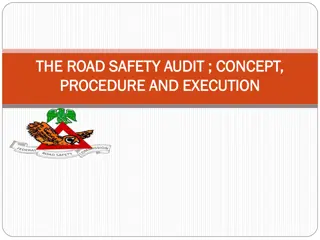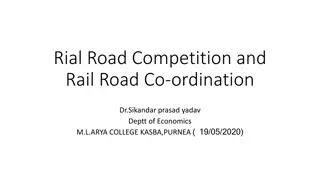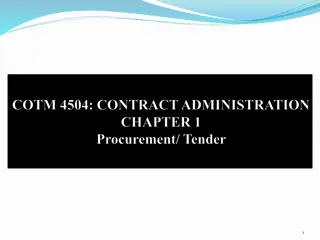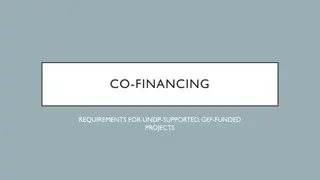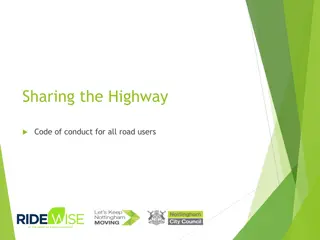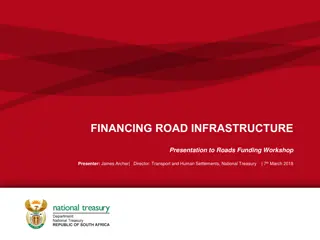Financing Challenges in Road Construction Business
Considerations in financing decisions and challenges in road construction, including rate risk, repayment cycles, global economic influences, and competition impacts. Gain insights into negotiating for finance and acquiring negotiation skills.
Download Presentation

Please find below an Image/Link to download the presentation.
The content on the website is provided AS IS for your information and personal use only. It may not be sold, licensed, or shared on other websites without obtaining consent from the author.If you encounter any issues during the download, it is possible that the publisher has removed the file from their server.
You are allowed to download the files provided on this website for personal or commercial use, subject to the condition that they are used lawfully. All files are the property of their respective owners.
The content on the website is provided AS IS for your information and personal use only. It may not be sold, licensed, or shared on other websites without obtaining consent from the author.
E N D
Presentation Transcript
Session Objectives Examine the Financing challenges in road construction. Session outcome: By the end of the session trainees should be able; To identify considerations in making a financing decision To know how to handle the financing challenges faced in road construction business M5S4 2
Session outcome To have an insight into the key psychological principles involved in achieving win/win negotiation To identify bottlenecks in negotiating for finance To acquire negotiations skills in dealing with financial institutions. M5S4 3
Specific Considerations of the Sessions 1) Long-term vs Short-term options 2) Rate Risk 3) Repayment Cycles 4) Global Economic Influences 5) Competition Considerations M5S4 4
Rate Risk Both lender and borrower face rate risk with long- term finance Predicting short-term interest rates is fairly easy and only marginally risky. Anticipating long-term rate changes is a formidable challenge, regardless of the "expert" predictions or available data Problems in raising long-term finance, particularly in a period of rate fluctuation uncertainty, are magnified when dramatic rate risk becomes reality M5S4 5
Repayment Cycles The longer the repayment cycle, the higher the risk to the borrower and lender Extended repayment cycles pose higher risk to both lenders and borrowers New businesses pose even potential problems as 80 percent of new businesses fail in the first two years. M5S4 6
Global Economic Influences The global economy, unlike in past decades, influences the availability of long-term finance As business results are more affected by conditions in Europe and Asia, long-term finance is often influenced on a local level. Long-term issues, with their inherent rate and repayment risk, are further complicated with world-wide economic influences M5S4 7
Competition Considerations. Competition always influences long-term finance Branding and public perception, regardless of local, national or global economic distress, are critical to availability of long-term finance Lenders, particularly commercial banks, need to maintain strong long-term finance efforts. Lenders must monitor and meet competitive challenges to succeed. M5S4 8
General considerations to negotiate for The interest rate How the rates are set (fixed or variable) Repayment period Grace period Frequency of repayment Size of instalments Loan termination penalties Default interest Security insurance, restriction M5S4 9
Considerations Administrative costs Commitment fee Security revaluation and frequency Early repayment conditions Other conditions M5S4 10
Negotiations skills in finance The negotiations process is made up of five steps: 1) Preparation and planning 2) Definition of ground rules 3) Clarification and justification 4) Bargaining and problems 5) Closure and implementation M5S4 11
Negotiating Fair Financial Conditions Conditions and constraints that require a company to operate within specified financial parameters, maintain certain ratios, disallow specific balance sheet items, or limit some actions. M5S4 12
Key considerations: Negotiate conditions & terms that provide enough flexibility to run the business properly. Clarity is required about any types of conditions that could potentially hobble or harm the business. Negotiating power is a reflection of the relationship with the lender It is advantageous to talk with more than one lender M5S4 13
Understand the lenders perspective: Draw up a list of conditions a lender would be expected to require Develop a realistic set of conditions that reflect the company s perspective Consider what kind of condition& terms structure is reasonable based on the company s business form, financial condition, and strategic objectives Keep in touch with the lenders and update them regularly of performance. M5S4 14
Avoid strict technical default clauses Avoid very stringent technical default terms Ensure that the company will receive adequate notice Have an opportunity to address any problems before this occurs. Conditions & terms should be reviewed collectively with the outcome in mind M5S4 15
Contd. Measure proposed conditions against the most recent financials and future projections Create a proactive system to monitor adherence to all financial loan conditions & terms. Communicate regularly with lenders so there is clear understanding of the factors driving their credit decisions M5S4 16
Discussion 1. Suggest possible loan conditions (covenants) banks may require in typical loan agreement. 2. Describe the appropriate steps necessary to adequately prepare for negotiation for finance. 3. From the master case study identify key reasons why Munaku could not easily access bank credit. 4. Suggest reasons why do banks add conditions(or covenants) to loan agreements 5. Discuss the key considerations in making a financing decision M5S4 17






